Twitch Business Model Canvas 2024
Originally launched as a platform focused solely on video game live streaming, Twitch has since evolved into an expansive live streaming community for all types of content, from gaming, music, and sports to just chatting, captivating millions of daily active users with its real-time interactivity. Here in this Twitch business model canvas, we will learn its customer segments, value proposition, revenue streams, channels, customer relationships, key activities, key resources, key partners, and cost structure.
Interesting fact!
Twitch was founded by Justin Kan and Emmett Shear as a spin-off of their previous startup, Justin TV.
Twitch Competitors
YouTube Gaming | Facebook Gaming | Caffeine | Microsoft Mixer | Smashcast | Uplive | Nimo TV | Douyu | Huya
Customer Segments – Twitch Business Model Canvas
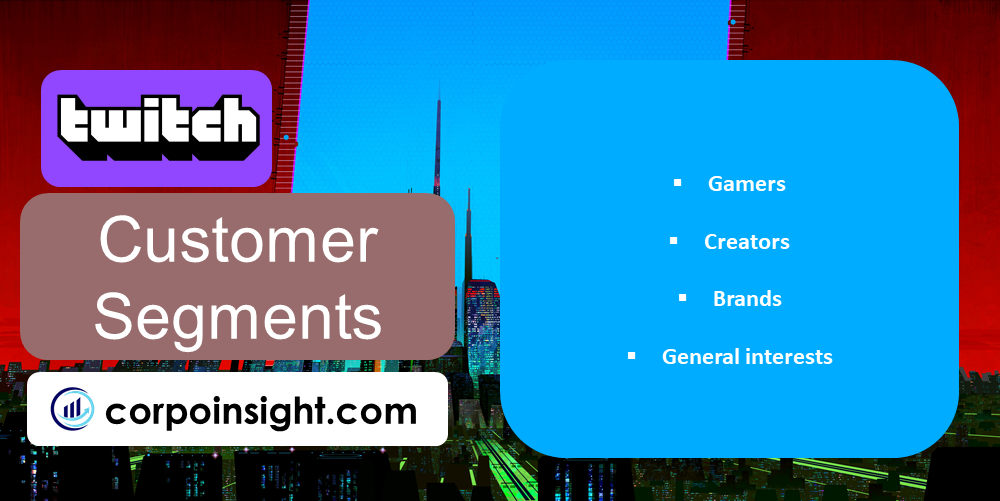
Gamers: Twitch attracts a massive community of over 15 million daily active gamers who watch and interact with video game live streams, as gaming content comprised over 80% of Twitch viewing hours in 2021.
Creators: Twitch has over 8 million unique creators streaming each month, ranging from amateurs to full-time professional streamers, who leverage Twitch’s platform and monetization tools.
Brands: Major consumer brands partner with influential Twitch streamers and advertise on the platform to market products to Twitch’s young, tech-savvy audiences. Twitch’s sponsorship revenue doubled in 2020.
General interests: Beyond gaming, Twitch draws audiences interested in live streams of sports, music, talk shows, and other real-life content, which account for 20% of viewing hours.
Value Proposition – Twitch Business Model Canvas
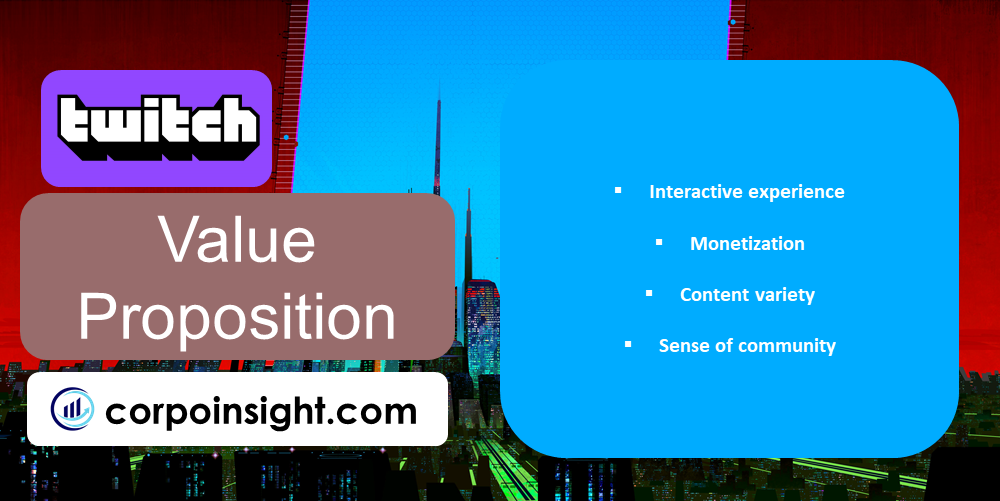
Interactive experience: Twitch provides a highly engaging experience by enabling real-time chat interaction between viewers and streamers during live broadcasts, distinguishing it from pre-recorded video platforms.
Monetization: Twitch lets creators monetize their streams through subscriptions, donations, ads, and partnerships, attracting millions to broadcast on the platform and providing continuous fresh content.
Content variety: Twitch hosts a vast range of gaming and IRL content, from casual gameplay to eSports tournaments and live concerts, catering to diverse preferences.
Sense of community: With its own cultural norms and emotes, Twitch fosters a strong sense of community, letting viewers feel connected to streamers and other fans.
Revenue Streams – Twitch Business Model Canvas
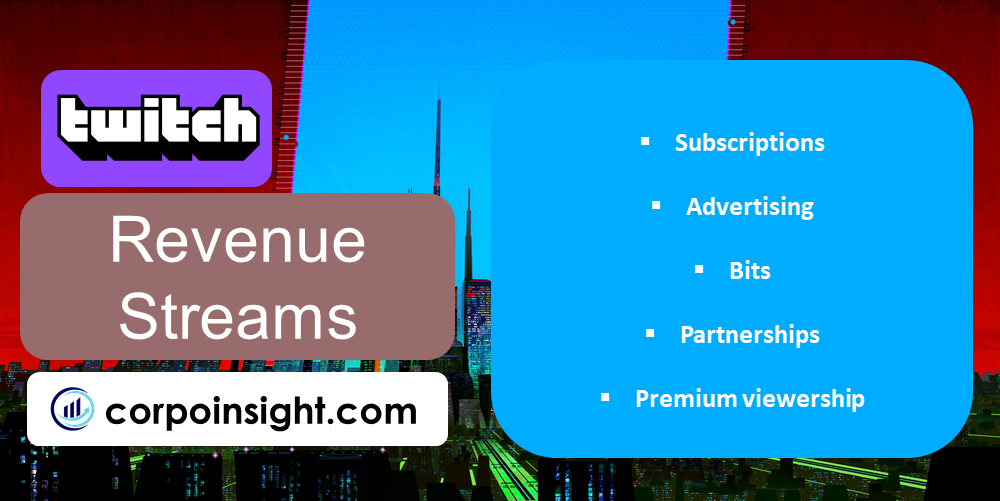
Subscriptions: Viewers pay $4.99 to $24.99 per month for privileges like ad-free viewing and subscriber-only chats. Twitch takes a cut.
Advertising: Twitch generated over $230 million in ad revenue in 2020 by selling video ads, display ads, sponsorships, and branded virtual goods.
Bits: Users pay real money to purchase Bits, Twitch’s virtual goods, to cheer and financially support streamers. Twitch takes a share.
Partnerships: Twitch gives a portion of the payouts from paid channel subscriptions, and exclusive Cheer Bit deals to popular productive partners.
Premium viewership: Twitch Turbo offers an ad-free viewing experience for $8.99 per month, while Prime members get free subs.
Channels – Twitch Business Model Canvas
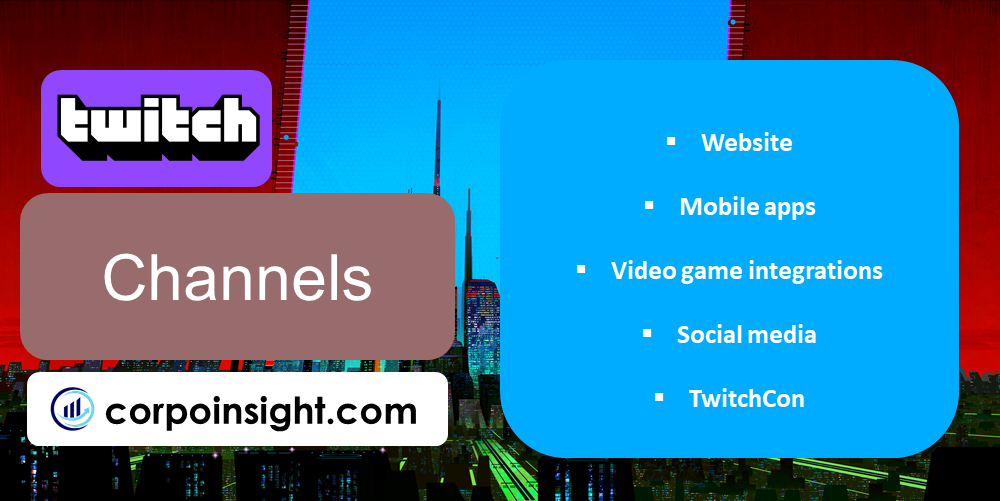
Website: Twitch’s website enables live streaming, VOD playback, and community features like chat and profiles. It had over 30 billion hours watched in 2020.
Mobile apps: Twitch’s iOS and Android apps allow viewing streams on the go. The apps have over 125 million installs and facilitate mobile live streaming.
Video game integrations: Twitch partnerships allow streamers to live broadcast directly from games like Fortnite and Minecraft, bolstering content.
Social media: Twitch leverages its Twitter, Instagram, YouTube, and Discord to promote content, engage fans, and direct them to the main platform.
TwitchCon: The annual TwitchCon events strengthen the brand community by letting fans meet creators in person and preview new platform features.
Customer Relationships – Twitch Business Model Canvas
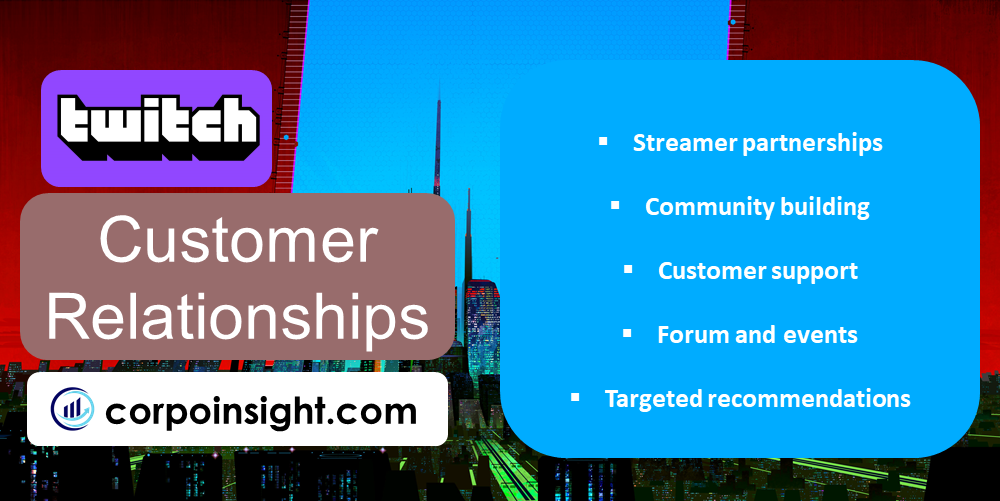
Streamer partnerships: Twitch cultivates relationships with top streamers through revenue sharing, promotional support, and facilities like Streamer Camps.
Community building: Twitch fosters an engaged, interactive community experience through chat, emotes, and a culture defined by memes and slang terms.
Customer support: Twitch provides extensive help center articles, email/chat support, and a presence on social media to address user issues promptly.
Forum and events: Twitch’s user forum and live events like TwitchCon let the company gather direct feedback from the gaming community.
Targeted recommendations: Twitch’s recommendation algorithm serves customizable content to match viewers’ interests based on watch history and followers.
Key Activities – Twitch Business Model Canvas

Product development: Twitch invests heavily in enhancing platform features like stream quality, discovery tools, extensions, prime benefits, and viewer engagement options.
Content moderation: Twitch employs a large moderation team and safety tools like auto-detections, bans, and suspensions to uphold community guidelines.
Streaming technology: Twitch continuously optimizes its low latency video streaming and adaptive bitrate technology to support high-quality broadcasts at scale.
Partner program: Onboarding and supporting streamer partners via revenue sharing, promotional support, and exclusivity deals is vital to populating fresh content.
Advertising network: Twitch works to expand its digital advertising capabilities across formats like video ads, banners, and sponsorships in order to ramp up revenue.
Key Resources – Twitch Business Model Canvas
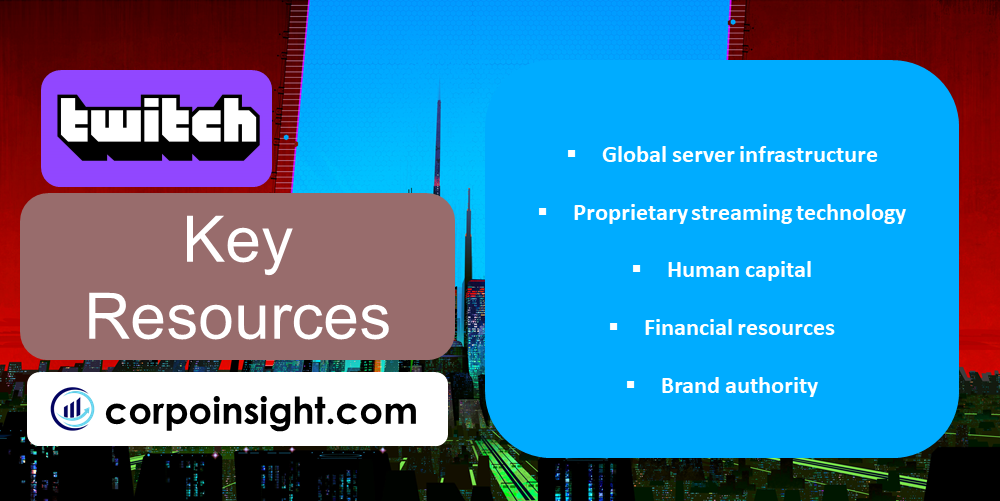
Global server infrastructure: Twitch has deployed thousands of ingest and delivery servers worldwide to handle uploading and serving high-quality video to millions concurrently.
Proprietary streaming technology: Twitch continually enhances its low latency video streaming and adaptive bitrate technologies like NVIDIA Shield and FTL to support an optimal viewing experience.
Human capital: Twitch employs top engineering talent with specializations in areas like video, peer-to-peer networks, and scalable architectures to maintain its platform.
Financial resources: Being acquired by Amazon for $970 million gave Twitch ample capital to invest in expanding its platform capabilities and content scope globally.
Brand authority: Twitch has established itself as the go-to place for gaming & esports live streaming, giving it a competitive edge.
Key Partners – Twitch Business Model Canvas
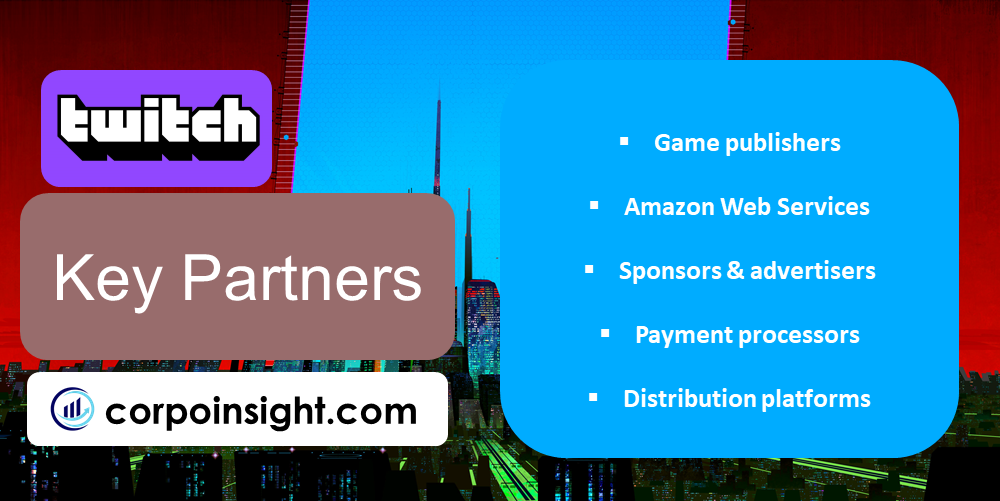
Game publishers: Game publishers partner with Twitch for integrations that let gamers live stream gameplay directly from titles like Fortnite and Minecraft.
Amazon Web Services: Twitch leverages AWS’s cloud platform for its storage, computing, database, and delivery needs to scale reliably and cost-efficiently.
Sponsors & Advertisers: Major brands sponsor events and individual streamers while advertisers buy various ad products to reach Twitch’s audiences.
Payment processors: Services like PayPal, Braintree, and BitPay enable Twitch to accept user payments for subscriptions, Cheering Bits, etc.
Distribution platforms: Integrations with platforms like Facebook Gaming and TikTok expand Twitch’s reach, while console integrations boost gaming live streams.
Cost Structure – Twitch Business Model Canvas
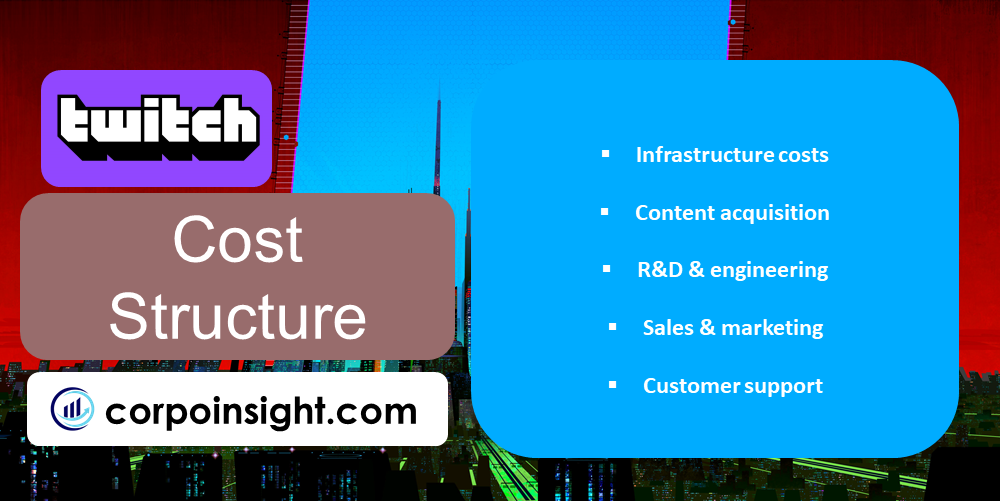
Infrastructure costs: Twitch incurs major costs to run its global server fleet, data centers, and high-speed bandwidth to support fast live video streaming.
Content acquisition: Paid partnerships with top gaming personalities and exclusive rights to esports events come at a high cost to attract audiences.
RD & engineering: With over 1000 technical staffers, Twitch invests heavily in R&D and engineering to enhance its proprietary platform and streaming tech.
Sales & Marketing: Twitch spends significantly on advertising, promotional events, and staff to acquire new viewers and streamers and expand globally.
Customer support: The company maintains large teams of customer support agents available 24/7 to address user issues promptly via chat, email, and social media
Summary of Twitch Business Model Canvas
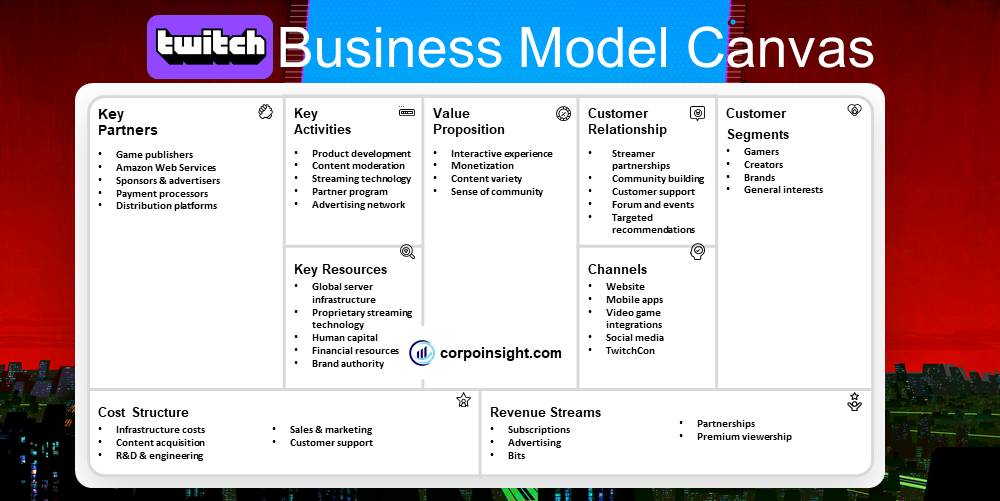
Conclusion on Twitch Business Model Canvas
Twitch has leveraged its massive gamer community, proprietary streaming technology, partnerships with top content creators, and monetization capabilities to establish itself as the leading live streaming platform for gaming, esports, and beyond, cultivating an engaged audience that has made video game live streaming a cultural phenomenon.

Majoring in marketing from Bangladesh University of Professionals, Sadman Abrar is a learner, obsessed with branding and intrigued to learn about different company strategies, and currently working at bKash.





